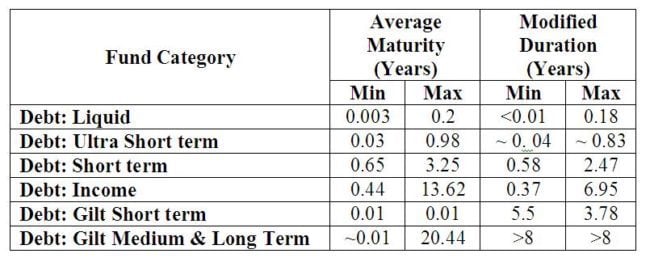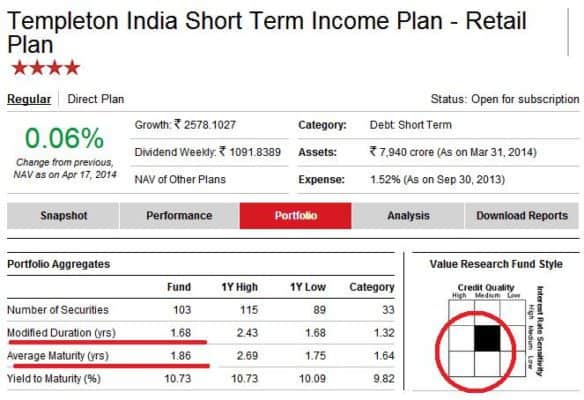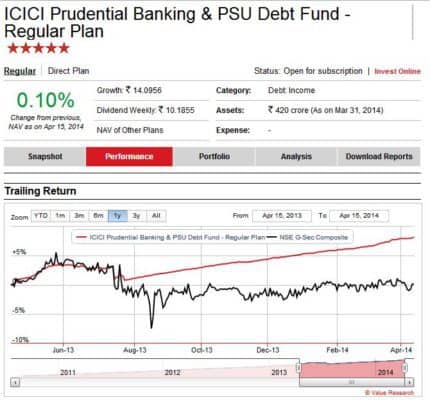Last Updated on April 26, 2025 at 9:24 pm
Since the time my step-by-step guide to selecting (Equity) mutual funds become popular, I have been receiving requests to publish a similar guide for debt mutual funds.
Well begun is half-done. If an investor can confidently select categories suitable for their financial goals, short-listing a set of funds from that category is that much easier. This is especially true for debt funds, since choosing one is typically tougher than equity funds.
Although I intended this post to be a companion piece to the more general, How to select mutual fund categories suitable for your financial goals, as I wrote it, enough aspects have been included to consider this as a step-by-step selection guide for debt funds.
Interest rates and bond prices have a fascinating relationship. Therefore, besides the usual risk-return parameters of alpha, beta, standard deviation, Sharpe ratio, Sortino ratio etc used for equity mutual funds, quantities like yield, yield to maturity, average portfolio duration, modified duration etc. are involved in debt fund selection/evaluation.
Join 32,000+ readers and get free money management solutions delivered to your inbox! Subscribe to get posts via email! (Link takes you to our email sign-up form)
🔥Want to create a complete financial plan? Learn goal-based investing? Exclusive access to our DIY tools? Increase your income with your skills? Use this link to enjoy massive discounts on our robo-advisory tool & courses! 🔥
This makes the selection process appear complicated. However, this can be simplified by focussing on 1/2 parameters to first narrow down the debt fund category and then short-list funds from that category.
Thanks to the recent crash in bond prices, a visual analysis is possible.
On July 16th 2013, the 10-year G-sec rate increased by 6.69% while the 1-year G-sec rate increased by a whopping 14.8%. Source: www.investing.com
While the steps taken by RBI to curb rupee-depreciation was the main reason for this, other events played a part too. See here for a decent report.
The value of a bond has an inverse relationship with interest rate. If interest rates increase, the value of a bond has to fall in order to match current yields. Therefore, the NAV of a bond fund holding such bonds will decrease.
Since both the 1Y and 10Y rate jumped up sharply, pretty much bonds of all durations were affected, resulting in a fall in NAV of almost all types of funds.
Even liquid and ultra –short term funds, with maturity durations much less than a year, were affected, because banks pulled out huge amounts of money stashed in such funds.
Since this event occurred less than a year ago, the default option (1Y) in the performance tab of each debt fund page at Value Research Online shows how funds behaved during this period.
This offers a simple way to understand how different types of debt funds react to interest rate movements, aka interest rate risk – one type of risk that debt funds are subject to.
First, let me quote two definitions:
Modified Duration : Measured in years, modified duration is a measurement of a bond’s sensitivity to movements in interest rates. For example, a bond with a modified duration of 5.2 years can be expected to undergo a 5.2% movement in price for each 1% movement in interest rates. The longer the modified duration (in years), the more sensitive a bond’s price to changes in interest rates. Source: Invesco Perpetual
Average Maturity: The average maturity of the portfolio determines the time involved in maturing of all the debt assets in the portfolio of the debt mutual fund. Higher the average maturity of the portfolio greater would be the interest rate risk on the portfolio of the debt mutual fund. Source: MoneyControl
Both the modified duration and the average maturity represent the sensitivity of the debt fund portfolio to interest rate movements.
While average maturity is a crude measure of interest rate sensitivity, the modified duration is a more sensitive measure.
Just by noting the values of these two parameters, one can understand how interest rate risk affects different debt fund categories.
Here is a compilation of average maturity and modified duration for different fund classes. I have deliberately avoided defining each fund category in the post. Those who are familiar with them should not worry too much. If you are new to debt funds, then I suggest you come up with your own definition of fund categories by observing the maximum values of the average maturity and modified duration.

Performance in the past year
Debt: Liquid. Let us look at the fund with highest average maturity (AM) (0.2 years) and highest modified duration (MD) (0.18 years).
Notice the little bump in the NSE Treasury Bill a little after the bond crash. The fund however was practically unharmed. If you peer a little you will notice a small dip on July 16th. Notice how fast the fund bounced back – in a few days.
Debt: Income Let us look at two funds.
The fund with lowest category AM = 0.44 years , MD =0.37 years
Notice how the fund suffered a dip on July 16th but recovered in a couple of months.
Now let us look at the fund with the highest category AM = 13.62 years; MD = 6.95 years.
The fund is yet to reach its July 16th NAV.
Similar plots can be made for the short term gilt funds. Imagine the fate of the Debt: long term funds!
Therefore, in general, higher the average maturity of the portfolio, higher the interest rate risk.
Higher the average maturity, higher the modified duration.
Higher the modified duration, higher the interest rate risk. The value of the modified duration gives you a more exact estimate of how much the NAV will be affect for 1% change in interest rates.
Typically funds with low AM and MD will follow an accrual strategy. That is they will buy and hold debt paper until maturity. So interest rate risk is lowered. However, credit risk comes into play. Lower the quality of the debt paper, higher the credit risk and higher the interest rate!
SEBI allows fund houses to buy credit protection (sort of an insurance) to hedge credit risk on corporate bonds. So that offers some comfort to the investors.
How do we use this information to select mutual funds?
When it comes to debt fund investors, I can think of three types
1) Those who are always chasing interest rates, double indexation etc.
2) Those who are looking to invest for short term goals, less than 5 years away
3) Those who are looking to invest for long term goals, as part of diversified folio.
We will leave type (1) alone. Obviously they know what they are doing. We will leave the high AM, high MD funds to these guys.
Where kind of funds should type (2) investors choose?
They should choose a fund with average maturity well below the tenure of the financial goal.
For a 5 year goal, I would choose a modified duration and average maturity of no more than 1 year.
Which kind of fund to invest in? Now we will need to look into the nature of the debt holdings. Is it corporate debt? It is Bank paper? It is govt debt (gilt)? What is the rating of the debt paper?
For important goals, best to stick to high quality debt issued by banks and PSU
Short term gilt funds with lower MD can also be used, but the returns would be on the lower side.
For less-important goals, you can be a little more adventurous and include some corporate debt. Here again stick to funds that have predominantly ‘AAA’ securities in their folio.
So investors should first look at low interest rate. The risk (AM & MD) , shortlist couple of fund categories and then choose funds with low credit risk (quality of debt).
Here is a screenshot from the ValueResearch portfolio page showing the AM, MD and the fund style box. We should funds with high credit quality and low interest rate sensitivity for short term goals. Most investors with a goal in mind, should stay within the red circle.

Once the fund category is chosen, you can short list funds using the risk-return parameters (alpha, beta, standard deviation, R-squared, Sharpe ratio) using the same strategy as outlined in the step-by-step mutual fund selection guide. If you would like to understand risk-return parameters in a simple non-mathematical way, click here
This would enable you to short-list low-risk, reasonable-return funds from the category of your choice.
The next step would be to look at the fund objective and investment strategy. Some fund houses like Franklin Templeton mention this clearly on each fund page. If the information is not clear, read the scheme document. Do not ask anyone else!
The objective and investment strategy must give you the impression that the current AM and MD will more or less be the same for the investment tenure you have in mind.
If yes, go ahead and invest!
NEVER invest in a debt fund without reading the investment objective and investment strategy.
Where kind of funds should type (3) investors choose?
First let us understand what we need debt funds for long term goals which would typically have significant equity.
- Why not PPF? PPF is not suitable for goals less than 15 financial years away
- PPF is good but it does not allow rebalancing. You can book profits into PPF but not vice versa when you want to.
- With a debt fund there is a chance for high returns which could be transferred to equity when the markets fall. So debt funds allow for rebalancing which if done cleverly can contain portfolio volatility significantly.
Just like a diversified equity fund, a well diversified debt fund like a dynamic bond fund with modified duration and average maturity of no more than 2-3 years will do the work. The NAV will fluctuate and that is fine, since we need fluctuations for rebalancing! You can learn more about rebalancing here. Be sure to play with the simulator tool.
Just as the concept of standard deviation can help a newbie mf investor understand different fund categories, the concepts of average maturity, and modified duration can help the newbie debt fund investor to pick a category suitable for their needs.
Debt funds selection can typically be more complicated than equity fund selection. It is up to the investor to simplify this process by being clear on what they want. They should learn not to chase after returns and keep expectations low.

Use our Robo-advisory Tool to create a complete financial plan! ⇐More than 3,000 investors and advisors use this! Use the discount code: robo25 for a 20% discount. Plan your retirement (early, normal, before, and after), as well as non-recurring financial goals (such as child education) and recurring financial goals (like holidays and appliance purchases). The tool would help anyone aged 18 to 80 plan for their retirement, as well as six other non-recurring financial goals and four recurring financial goals, with a detailed cash flow summary.
🔥You can also avail massive discounts on our courses and the freefincal investor circle! 🔥& join our community of 8000+ users!
Track your mutual funds and stock investments with this Google Sheet!
We also publish monthly equity mutual funds, debt and hybrid mutual funds, index funds, and ETF screeners, as well as momentum and low-volatility stock screeners.
You can follow our articles on Google News

We have over 1,000 videos on YouTube!

Join our WhatsApp Channel



- Do you have a comment about the above article? Reach out to us on Twitter: @freefincal or @pattufreefincal
- Have a question? Subscribe to our newsletter using the form below.
- Hit 'reply' to any email from us! We do not offer personalised investment advice. We can write a detailed article without mentioning your name if you have a generic question.
Join 32,000+ readers and get free money management solutions delivered to your inbox! Subscribe to get posts via email! (Link takes you to our email sign-up form)
About The Author
 Dr M. Pattabiraman (PhD) is the founder, managing editor and primary author of freefincal. He is an associate professor at the Indian Institute of Technology, Madras. He has over 13 years of experience publishing news analysis, research and financial product development. Connect with him via Twitter(X), LinkedIn, or YouTube. Pattabiraman has co-authored three print books: (1) You can be rich too with goal-based investing (CNBC TV18) for DIY investors. (2) Gamechanger for young earners. (3) Chinchu Gets a Superpower! for kids. He has also written seven other free e-books on various money management topics. He is a patron and co-founder of “Fee-only India,” an organisation promoting unbiased, commission-free, AUM-independent investment advice.
Dr M. Pattabiraman (PhD) is the founder, managing editor and primary author of freefincal. He is an associate professor at the Indian Institute of Technology, Madras. He has over 13 years of experience publishing news analysis, research and financial product development. Connect with him via Twitter(X), LinkedIn, or YouTube. Pattabiraman has co-authored three print books: (1) You can be rich too with goal-based investing (CNBC TV18) for DIY investors. (2) Gamechanger for young earners. (3) Chinchu Gets a Superpower! for kids. He has also written seven other free e-books on various money management topics. He is a patron and co-founder of “Fee-only India,” an organisation promoting unbiased, commission-free, AUM-independent investment advice.Our flagship course! Learn to manage your portfolio like a pro to achieve your goals regardless of market conditions! ⇐ More than 3,500 investors and advisors are part of our exclusive community! Get clarity on how to plan for your goals and achieve the necessary corpus no matter the market condition!! Watch the first lecture for free! One-time payment! No recurring fees! Life-long access to videos! Reduce fear, uncertainty and doubt while investing! Learn how to plan for your goals before and after retirement with confidence.
Increase your income by getting people to pay for your skills! ⇐ More than 800 salaried employees, entrepreneurs and financial advisors are part of our exclusive community! Learn how to get people to pay for your skills! Whether you are a professional or small business owner seeking more clients through online visibility, or a salaried individual looking for a side income or passive income, we will show you how to achieve this by showcasing your skills and building a community that trusts and pays you. (watch 1st lecture for free). One-time payment! No recurring fees! Life-long access to videos!
Our book for kids: “Chinchu Gets a Superpower!” is now available!


Must-read book even for adults! This is something that every parent should teach their kids right from their young age. The importance of money management and decision making based on their wants and needs. Very nicely written in simple terms. - Arun.Buy the book: Chinchu gets a superpower for your child!
How to profit from content writing: Our new ebook is for those interested in getting a side income via content writing. It is available at a 50% discount for Rs. 500 only!
Do you want to check if the market is overvalued or undervalued? Use our market valuation tool (it will work with any index!), or get the Tactical Buy/Sell timing tool!
We publish monthly mutual fund screeners and momentum, low-volatility stock screeners.
About freefincal & its content policy. Freefincal is a News Media organisation dedicated to providing original analysis, reports, reviews and insights on mutual funds, stocks, investing, retirement and personal finance developments. We do so without conflict of interest and bias. Follow us on Google News. Freefincal serves more than three million readers a year (5 million page views) with articles based only on factual information and detailed analysis by its authors. All statements made will be verified with credible and knowledgeable sources before publication. Freefincal does not publish paid articles, promotions, PR, satire or opinions without data. All opinions will be inferences backed by verifiable, reproducible evidence/data. Contact Information: To get in touch, please use our contact form. (Sponsored posts or paid collaborations will not be entertained.)
Connect with us on social media
- Twitter @freefincal
- Subscribe to our YouTube Videos
- Posts feed via Feedburner.
Our publications
You Can Be Rich Too with Goal-Based Investing
 Published by CNBC TV18, this book is designed to help you ask the right questions and find the correct answers. Additionally, it comes with nine online calculators, allowing you to create custom solutions tailored to your lifestyle. Get it now.
Published by CNBC TV18, this book is designed to help you ask the right questions and find the correct answers. Additionally, it comes with nine online calculators, allowing you to create custom solutions tailored to your lifestyle. Get it now.Gamechanger: Forget Startups, Join Corporate & Still Live the Rich Life You Want
 This book is designed for young earners to get their basics right from the start! It will also help you travel to exotic places at a low cost! Get it or gift it to a young earner.
This book is designed for young earners to get their basics right from the start! It will also help you travel to exotic places at a low cost! Get it or gift it to a young earner.Your Ultimate Guide to Travel
 This is an in-depth exploration of vacation planning, including finding affordable flights, budget accommodations, and practical travel tips. It also examines the benefits of travelling slowly, both financially and psychologically, with links to relevant web pages and guidance at every step. Get the PDF for Rs 300 (instant download)
This is an in-depth exploration of vacation planning, including finding affordable flights, budget accommodations, and practical travel tips. It also examines the benefits of travelling slowly, both financially and psychologically, with links to relevant web pages and guidance at every step. Get the PDF for Rs 300 (instant download)

